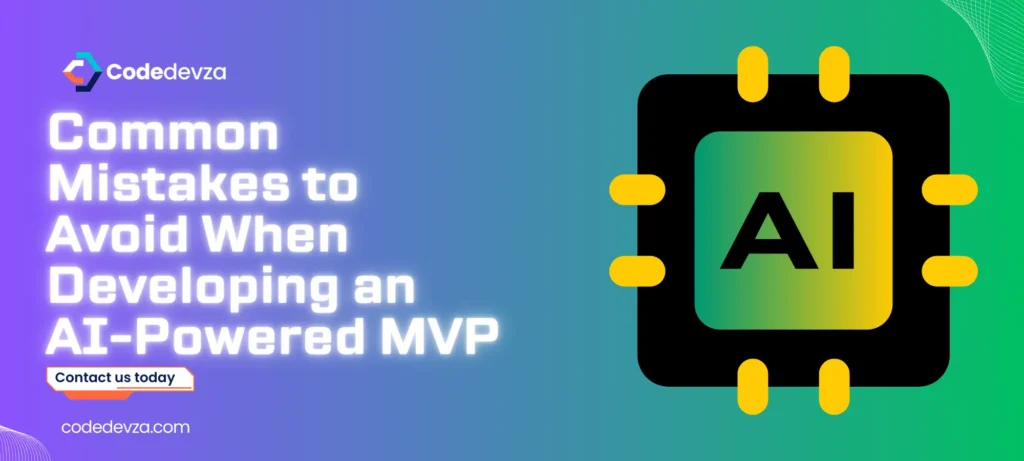AI-powered MVP development is an exciting yet challenging endeavor. Many startups and businesses dive into AI solutions to gain a competitive edge, but mistakes in the early stages can lead to failure or unnecessary complications. CodeDevza understands these challenges and helps businesses build scalable and efficient AI-driven products. Here are the most common mistakes to avoid when developing an AI-powered MVP and how to overcome them.
Choosing the Wrong Problem to Solve
One of the biggest mistakes in AI-powered MVP development is selecting a problem that doesn’t require AI. AI is a powerful tool, but it is not always the best solution for every challenge. Some businesses implement AI because it’s trendy rather than because it adds value.
How to Avoid:
- Clearly define the problem your AI-powered MVP will solve.
- Ensure that AI is the best approach by exploring other simpler alternatives.
- Validate the problem with market research and customer feedback.
Lack of Sufficient Data
AI models thrive on data. Many startups underestimate the importance of high-quality data in training their AI models, leading to poor performance and unreliable results.
How to Avoid:
- Gather diverse and high-quality datasets relevant to your business case.
- Ensure proper data cleaning and preprocessing before training your models.
- Consider synthetic data generation if real-world data is limited.
Overcomplicating the MVP
A common pitfall is making the MVP too complex. The purpose of an MVP is to test core functionality with minimal resources, not to launch a fully-fledged product.
How to Avoid:
- Focus on building a simple, functional prototype that solves the key problem.
- Use no-code or low-code solutions for quick prototyping.
- Iterate based on user feedback before adding advanced AI features.
Ignoring Model Explainability
AI models, especially deep learning algorithms, can be complex and opaque. If users and stakeholders cannot understand how your AI system makes decisions, they may not trust it.
How to Avoid:
- Use interpretable AI models whenever possible.
- Implement explainability techniques like SHAP or LIME.
- Provide clear documentation on how your AI system works.
Overlooking Ethical Considerations
AI can introduce biases and ethical concerns if not carefully designed. Ignoring these aspects can lead to user distrust and even legal consequences.
How to Avoid:
- Conduct bias audits on your training data.
- Ensure compliance with AI regulations and ethical standards.
- Design AI with fairness, transparency, and accountability in mind.
Failing to Plan for Scalability
Some startups build an MVP without considering how it will scale. As user demand grows, AI models may require significant computational power and optimized architectures.
How to Avoid:
- Choose scalable cloud solutions for AI deployment.
- Optimize your AI models for efficiency.
- Use modular architecture to allow easy upgrades.
Poor User Experience (UX) Integration
AI solutions should be user-friendly. If the AI-powered MVP lacks intuitive UX, users may struggle to interact with it effectively.
How to Avoid:
- Work with UX designers to create a seamless experience.
- Conduct user testing to identify usability issues.
- Provide clear instructions and support for users.
Underestimating Computational Costs
AI models, particularly deep learning, can be resource-intensive. Many startups fail to account for the long-term costs of cloud computing and AI infrastructure.
How to Avoid:
- Optimize models to reduce computational needs.
- Explore cost-effective cloud solutions like serverless AI.
- Consider edge AI for real-time, low-cost processing.
Neglecting Continuous Learning and Updates
AI models need continuous improvements based on real-world data. Failing to update models leads to performance degradation over time.
How to Avoid:
- Implement mechanisms for continuous learning.
- Monitor AI performance and retrain models periodically.
- Gather user feedback to refine AI behavior.
Skipping Security and Privacy Measures
AI models often handle sensitive data. Ignoring security and privacy can lead to data breaches and compliance violations.
How to Avoid:
- Implement robust encryption and access controls.
- Comply with data protection regulations like GDPR.
- Regularly test AI systems for security vulnerabilities.
Conclusion
Developing an AI-powered MVP requires careful planning and execution. By avoiding these common mistakes, startups can increase their chances of success. CodeDevza specializes in AI-powered MVP development, ensuring businesses avoid costly errors while building innovative solutions. If you’re ready to develop your AI-powered MVP the right way, Codedevza Technologies is here to help!
FAQs!
Q. What is an AI-powered MVP?
An AI-powered MVP (Minimum Viable Product) is a basic version of a product that integrates AI capabilities to test key functionalities and validate ideas before full-scale development.
Q. Why is data quality important in AI-powered MVP development?
AI models rely on high-quality data for accuracy. Poor data quality leads to unreliable results, bias, and suboptimal AI performance.
Q. How can I make my AI-powered MVP scalable?
Use cloud-based solutions, optimize model efficiency, and design a modular architecture that allows for easy upgrades as user demand grows.
Q. How do I ensure ethical AI development in my MVP?
Conduct bias audits, follow AI regulations, and prioritize transparency, fairness, and accountability in AI model design.
Q. What are the best tools for AI-powered MVP development?
Popular tools include TensorFlow, PyTorch, AWS AI services, Google AutoML, and low-code/no-code AI platforms like Bubble or Microsoft AI Builder.


